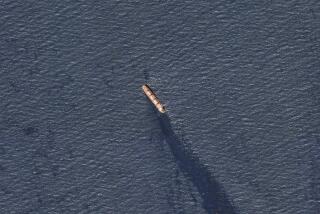Tanker Blast Could Have Wide Reach
- Share via
WASHINGTON — A terrorist attack on a tanker delivering liquefied natural gas at a U.S. port could set off a fire so hot it would burn skin and damage buildings nearly a mile away, government scientists said in a report expected to influence where multibillion-dollar terminals would be built on the California coast and elsewhere.
The report from a government nuclear weapons lab, a 160-page unclassified version of which was obtained Monday by Associated Press, characterized a liquefied natural gas spill from a terrorist attack as a low probability. If an attack were successful, however, it would become “a high consequence event” that could produce massive injuries and property damage, the report said.
The yearlong study by scientists at Sandia National Laboratories, a federal research facility, has provided the most detailed analysis of the potential outcome of a terrorist attack on a tanker transporting liquefied natural gas.
Although the report did not recommend prohibiting tankers from carrying the gas through heavily populated areas, it said those shipments should occur only after “the most rigorous deterrent measures” are in place to reduce the probability of an attack.
The tankers, each of which can carry up to 30 million gallons of liquefied natural gas, arrive every few days at four U.S. terminals: Everett, Mass.; Cove Point, Md.; Elba Island, Ga., and Lake Charles, La. All the sites are expanding as regulators weigh the merits of putting more than three dozen more such facilities at U.S. ports, many in urban areas.
Opponents of a proposed gas terminal in Long Beach said the report supported their view that liquefied natural gas was too dangerous to come through the port, part of the nation’s busiest seaport complex. A Mitsubishi Corp. subsidiary is seeking to build a terminal less than two miles from downtown Long Beach.
Bry Myown, a critic of the Long Beach terminal plan, said she thought the report underestimated the risks of liquefied natural gas, but did illustrate the risk posed to port-area residents and employees.
“We already are a target. We move 42% of the nation’s container trade,” she said, adding that a catastrophic liquefied natural gas fire at Long Beach’s port could spread to nearby gasoline and other chemical facilities.
Mitsubishi officials could not be reached Monday evening to comment on the report.
The Long Beach project is the only one proposed for an urban area in California, but two offshore facilities are proposed for the Ventura County coast. Two more are planned in Baja California, Mexico.
In its minus-260-degree liquid state, natural gas is not flammable. If a missile or explosive tears a hole in a tanker or a storage tank, however, the escaping liquid would be transformed instantaneously into a gas and probably would ignite in a massive fire.
The report, commissioned by the Energy Department, said terrorists -- using readily available weapons and technology -- could blast a 10-foot hole into the side of a tanker.
The study evaluates a range of scenarios that would result in the release of millions of gallons of liquefied natural gas from a transport tanker. The scenarios include a takeover of a vessel by a hijacker, attacks using explosive-laden boats and rocket-propelled grenades or missiles.
Detailed discussions of specific threats were included only in the classified version of the report, but the unclassified version examined the general impact such an attack -- and the resulting liquefied natural gas fire -- would have on people within a mile of the spill.
“We are not recommending that there be any kind of ‘no ship zone,’ ” said Mark Maddox, an Energy Department official. “What we’ve learned is that we can significantly reduce the likelihood of a terrorist attack occurring with security planning and mitigation.”
*
Times staff writer Deborah Schoch contributed to this report.
More to Read
Sign up for Essential California
The most important California stories and recommendations in your inbox every morning.
You may occasionally receive promotional content from the Los Angeles Times.












